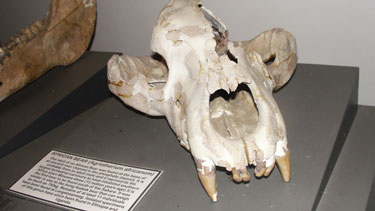‘Animal salad’ points to catastrophic demise
Curiosity killed the long-age paradigm


A few weeks ago, I drove out of Cape Town and headed north some 130 km (80 miles) to Langebaanweg (in the vicinity of Langebaan, Western Cape, South Africa). I visited the Fossil Park there that contains the bones of over 200 different species of animals buried in the sediments of an ancient flood.1 Walking down the gravel pathway to the site, I listened with half an ear to the mandatory plug for long ages delivered by a guide. He strangely came across as somewhat less than convinced about the 5-million-year time frame he was advocating.
The reason for his ambivalence was plain to see. My eldest son, Jonathan, uttered the most concise description of the chaos that lay before us. “Dad it’s an animal salad!” he enthused.

There before us were the bones of giant wild pigs, over 40 specimens of aardvarks, numerous long-necked and ‘short-necked’ giraffes (sivatheres), and 5 different species of hyena. Also an extinct form of hippo, a three-toed horse called hipparion, 3 species of elephant, bontebok antelopes as well as the boselaphine which today is found only in Asia, a saber-toothed cat, a wolverine, an enormous African bear, and a large number of smaller animals such as mice, mole rats, golden moles, frogs, and lizards including chameleons.2,3,4 Of birds there are no less than 10,000 (identified so far) bones of 90 different species, including marine birds such as cormorants, penguins, and an albatross, shorebirds, songbirds, parrots, woodpeckers, and at least one species of ostrich.2,5 Of even more importance, included in the jumble of bones are those of seals, whales and megalodon sharks, creating a mixture of marine, avian, and land mammal bones that were laid down in this single catastrophic event.
This jumble of death represents only a portion of the original find. Many tonnes were ground into fertilizers rich in phosphate from as early as 1943, long before scientists became involved and the fossil-find carefully preserved.
The evolutionary explanation for the mayhem under and around our feet is that 5 million years ago a precursor of the present Berg River flooded and the fossils are remnants of animals that were washed into the area. Interestingly, the information material refers to a catastrophic flood as well as the ocean levels being about 30 m (98 ft) higher than today—this is to account for the marine fossil/phosphate deposits.
The sheer numbers of creatures that died raises the question: what kind of river was this? Today, when a river floods, most, if not all, of the mammals quickly move away. What then of the scores of species of flying birds ranging from quails to albatrosses that were unable to simply lift their wings and fly away?




Truly, great credulity is required to swallow the deep-time, local-flood interpretation of the evidence, and none more so than at Langebaanweg. The deluge of Noah’s Flood, that covered the whole earth and lasted for an entire year, finds its confirmation primarily in the words that the Lord God of all the earth has spoken, but secondarily in the sediments of our planet. Nowhere is this clearer than at Langebaanweg on the far western shores of South Africa where the remains of so many mammals, birds and marine creatures are mixed up in one layer and this in an area no larger than a basketball court. Who knows what other exciting finds will be made as more of the area is exposed?
References and notes
- The Fossil Park occupies many hectares; some 80 m2 of the fossil bone bed is open for viewing by the public. Return to text.
- West Coast Fossil Park Fossil Animals Index; fossilpark.org.za/pages/fa-pathologies.html. Return to text.
- Hendey, Q.B., Past Life at Langebaan: West Coast Fossil Park; sawestcoast.com/fossil1.html. Return to text.
- West Coast Fossil Park, Western Cape; southafrica.net/za/en/articles/entry/article-west-coast-fossil-park, accessed 11 March 2016. Return to text.
- Guth, A., Understanding past climate and ecosystems, geology.com/articles/understanding-past-climate-and-ecosystems, accessed 11 March 2016. Return to text.


Readers’ comments
Comments are automatically closed 14 days after publication.